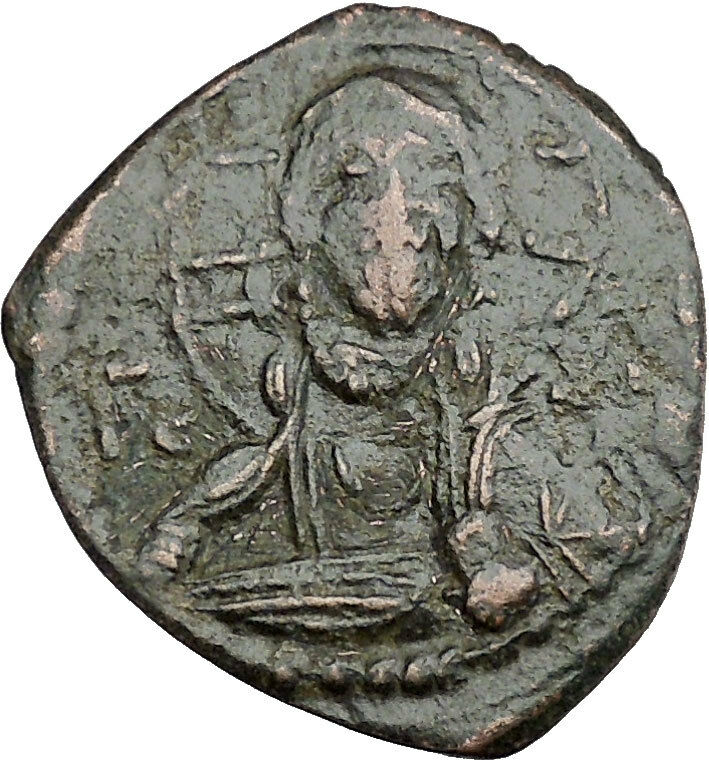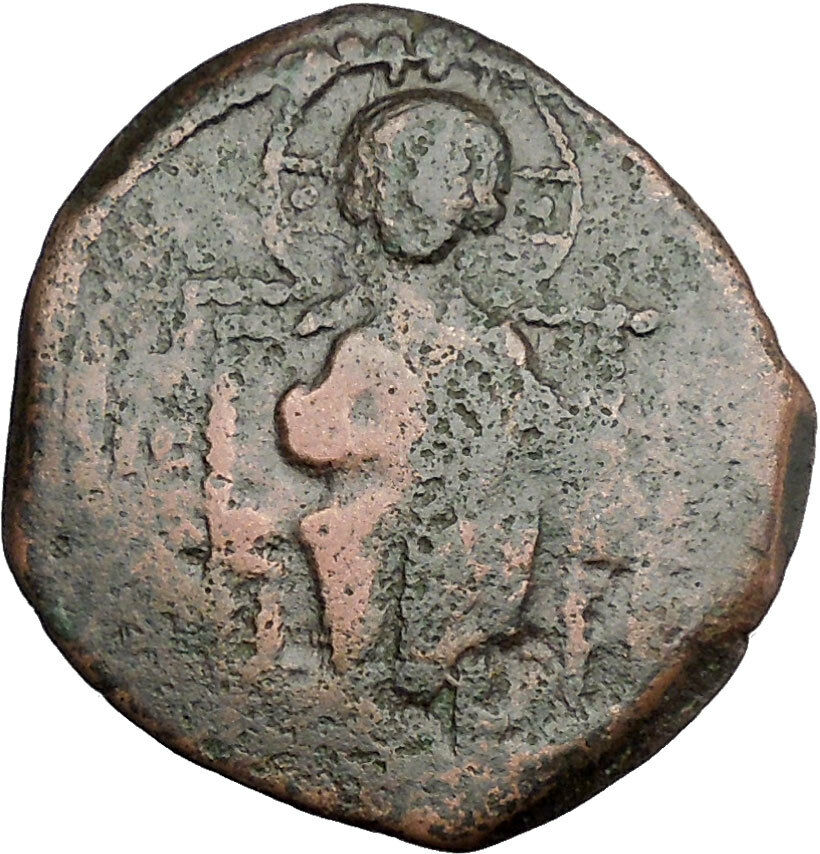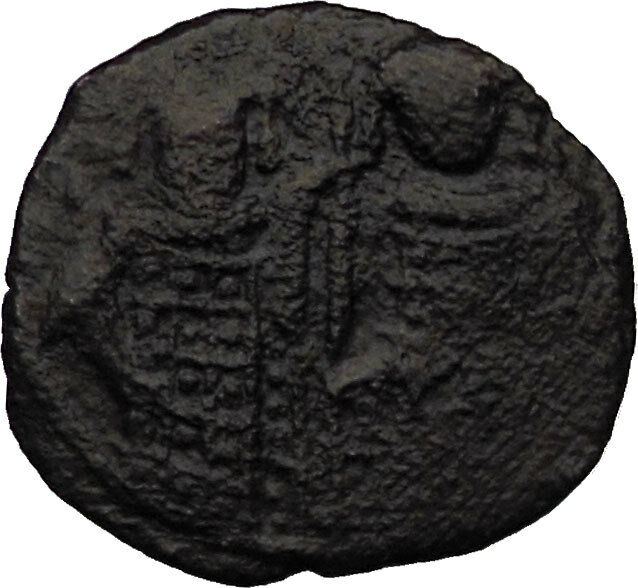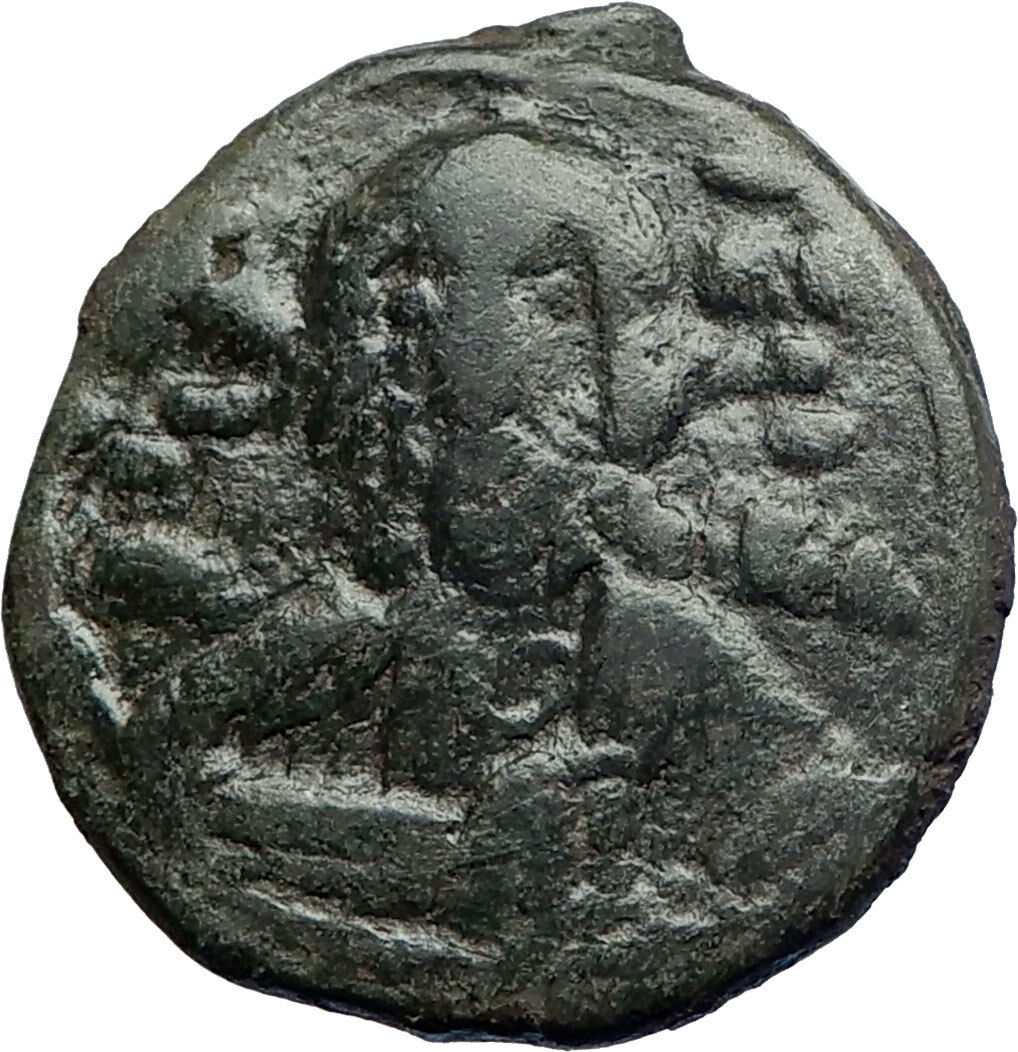|
Byzantine Empire – Anonymous Class D
Bronze Follis 30mm (8.56 grams) Constantinople mint, struck circa 1042-1060 A.D.
Reference: Sear 1836
Christ seated facing on throne with back, wearing nimbus crown, pallium and colobium, and holding book of Gospels with both hands; in field to left, IC; to right, XC.
IS XS / bASILЄ / bASIL (“Jesus Christ King of Kings”) in three lines; above, cross.
This type is often overstruck on folles of Class C. In the Dumbarton Oaks Catalogue it is suggested that Class D was introduced by Constantine IX following the death of Empress Zoe in 1050. It is further suggested that the type remained in issue for about a decade, throughout the three succeeding reigns, until finally superseded by Class E under Constantine X, circa 1060.
For more than a century, the production of Follis denomination Byzantine coins had religious Christian motifs which included included Jesus Christ, and even Virgin Mary. These coins were designed to honor Christ and recognize the subservient role of the Byzantine emperor, with many of the reverse inscriptions translating to “Jesus Christ King of Kings” and “May Jesus Christ Conquer”. The Follis denomination coins were the largest bronze denomination coins issued by the Byzantine empire, and their large size, along with the Christian motif make them a popular coin type for collectors. This series ran from the period of Byzantine emperors John I (969-976 A.D.) to Alexius I (1081-1118 A.D.). The accepted classification was originally devised by Miss Margaret Thompson with her study of these types of coins. World famous numismatic author, David R. Sear adopted this classification system for his book entitled, Byzantine Coins and Their Values. The references about this coin site Mr. Sear’s book by the number that they appear in that work. The class types of coins included Class A1, Class A2, Class A3, Class B, Class C, Class D, Class E, Class F, Class G, Class H, Class I, Class J, Class K.
-
Read the JESUS CHRIST Anonymous Class A-N Byzantine Follis Coins Reference and Guide
-
See ALL the Jesus Christ Anonymous Follis coins for sale.
-
See ALL coins bearing Jesus Christ or related available for sale.
You are bidding on the exact item pictured, provided with a Certificate of Authenticity and Lifetime Guarantee of Authenticity.
 Jesus (7-2 BC to AD 30-33), also referred to as Jesus of Nazareth or Jesus Christ, is the central figure of Christianity, whom the teachings of most Christian denominations hold to be the Son of God. Christians believe Jesus is the awaited Messiah (or Christ, the Anointed One) of the Old Testament. Jesus (7-2 BC to AD 30-33), also referred to as Jesus of Nazareth or Jesus Christ, is the central figure of Christianity, whom the teachings of most Christian denominations hold to be the Son of God. Christians believe Jesus is the awaited Messiah (or Christ, the Anointed One) of the Old Testament.
Virtually all modern scholars of antiquity agree that Jesus existed historically, and historians consider the Synoptic Gospels (Matthew, Mark and Luke) to be the best sources for investigating the historical Jesus. Most scholars agree that Jesus was a Galilean, Jewish rabbi who preached his message orally, was baptized by John the Baptist, and was crucified by the order of the Roman Prefect Pontius Pilate. In the current mainstream view, Jesus was an apocalyptic preacher and the founder of a renewal movement within Judaism, although some prominent scholars argue that he was not apocalyptic. After Jesus’ death, his followers believed he was resurrected, and the community they formed eventually became the Christian church. The widely used calendar era, abbreviated as “AD” from the Latin “Anno Domini” (“in the year of our Lord”) or sometimes as “CE”, is based on the birth of Jesus.
 Christians believe that Jesus has a “unique significance” in the world. Christian doctrines include the beliefs that Jesus was conceived by the Holy Spirit, was born of a virgin named Mary, performed miracles, founded the Church, died by crucifixion as a sacrifice to achieve atonement, rose from the dead, and ascended into Heaven, whence he will return. Most Christians believe Jesus enables humans to be reconciled to God, and will judge the dead either before or after their bodily resurrection, an event tied to the Second Coming of Jesus in Christian eschatology; though some believe Jesus’s role as savior has more existential or societal concerns than the afterlife, and a few notable theologians have suggested that Jesus will bring about a universal reconciliation. The great majority of Christians worship Jesus as the incarnation of God the Son, the second of three persons of a Divine Trinity. A few Christian groups reject Trinitarianism, wholly or partly, as non-scriptural. Christians believe that Jesus has a “unique significance” in the world. Christian doctrines include the beliefs that Jesus was conceived by the Holy Spirit, was born of a virgin named Mary, performed miracles, founded the Church, died by crucifixion as a sacrifice to achieve atonement, rose from the dead, and ascended into Heaven, whence he will return. Most Christians believe Jesus enables humans to be reconciled to God, and will judge the dead either before or after their bodily resurrection, an event tied to the Second Coming of Jesus in Christian eschatology; though some believe Jesus’s role as savior has more existential or societal concerns than the afterlife, and a few notable theologians have suggested that Jesus will bring about a universal reconciliation. The great majority of Christians worship Jesus as the incarnation of God the Son, the second of three persons of a Divine Trinity. A few Christian groups reject Trinitarianism, wholly or partly, as non-scriptural.
In Islam, Jesus (commonly transliterated as Isa) is considered one of God’s important prophets and the Messiah, second in importance only to Muhammad. To Muslims, Jesus was a bringer of scripture and was born of a virgin, but was not the Son of God. According to the Quran, Jesus was not crucified but was physically raised into Heaven by God. Judaism rejects the belief that Jesus was the awaited Messiah, arguing that he did not fulfill the Messianic prophecies in the Tanakh.
 Constantine IX Monomachos, Latinized as Constantine IX Monomachus (Greek: Κωνσταντῖνος Θ΄ Μονομάχος, Kōnstantinos IX Monomakhos; c. 1000 – 11 January 1055), reigned as Byzantine emperor from June 11, 1042 to January 11, 1055. He had been chosen by the Empress Zoe as a husband and co-emperor in 1042, although he had been exiled for conspiring against her previous husband, Emperor Michael IV the Paphlagonian. They ruled together until Zoe died in 1050. Constantine IX Monomachos, Latinized as Constantine IX Monomachus (Greek: Κωνσταντῖνος Θ΄ Μονομάχος, Kōnstantinos IX Monomakhos; c. 1000 – 11 January 1055), reigned as Byzantine emperor from June 11, 1042 to January 11, 1055. He had been chosen by the Empress Zoe as a husband and co-emperor in 1042, although he had been exiled for conspiring against her previous husband, Emperor Michael IV the Paphlagonian. They ruled together until Zoe died in 1050.
Early life
Constantine Monomachos was the son of Theodosios Monomachos, an important bureaucrat under Basil II and Constantine VIII. At some point, Theodosios had been suspected of conspiracy and his son’s career suffered accordingly. Constantine’s position improved after he married his second wife, a niece of Emperor Romanos III Argyros. Catching the eye of Empress Zoe, Constantine was exiled to Mytilene on the island of Lesbos by her second husband, Michael IV.
The death of Michael IV and the overthrow of Michael V in 1042 led to Constantine being recalled from his place of exile and appointed as a judge in Greece. However, prior to commencing his appointment, Constantine was summoned to Constantinople, where the fragile working relationship between Michael V’s successors, the empresses Zoe and Theodora, was breaking down. After two months of increasing acrimony between the two, Zoe decided to search for a new husband, thereby hoping to prevent her sister from increasing her popularity and authority.
After her first preference displayed contempt for the empress, and her second died under mysterious circumstances, Zoe remembered the handsome and urbane Constantine. The pair were married on June 11, 1042, without the participation of Patriarch Alexius I of Constantinople, who refused to officiate over a third marriage (for both spouses). On the following day, Constantine was formally proclaimed emperor together with Zoe and her sister Theodora.
Reign
Constantine continued the purge instituted by Zoe and Theodora, removing the relatives of Michael V from the court. The new emperor was pleasure-loving and prone to sudden violent outbursts on suspicion of conspiracy. He was heavily influenced by his mistress, Maria Skleraina, a niece of his second wife, and Maria’s relatives. In August 1042, under the influence of the Skleroi the emperor relieved General George Maniakes from his command in Italy, and Maniakes rebelled, declaring himself emperor in September. He transferred his troops into the Balkans and was about to defeat Constantine’s army in battle, when he was wounded and died on the field, ending the crisis in 1043.
Immediately after the victory, Constantine was attacked by a fleet from Kievan Rus’; it is “incontrovertible that a Rus’ detachment took part in the Maniakes rebellion”. They too were defeated, with the help of Greek fire. Constantine married his daughter Anastasia to the future Prince Vsevolod I of Kiev, the favorite son of his dangerous opponent Yaroslav I the Wise by Ingegerd Olofsdotter.
Constantine IX’s preferential treatment of Maria Skleraina in the early part of his reign led to rumours that she was planning to murder Zoe and Theodora. This led to a popular uprising by the citizens of Constantinople in 1044, which came dangerously close to actually harming Constantine who was participating in a religious procession along the streets of Constantinople. The mob was only quieted by the appearance at a balcony of Zoe and Theodora, who reassured the people that they were not in any danger of assassination.
In 1045 Constantine annexed the Armenian kingdom of Ani, according to a treaty between king John Smbat and Basil II, but this expansion merely exposed the empire to new enemies. In 1046 the Byzantines came into contact for the first time with the Seljuk Turks. They met in battle in Armenia in 1048 and settled a truce the following year. Even if the Seljuk rulers were willing to abide by the treaty, their unruly Turcoman allies showed much less restraint. Thus Constantine weakened the Byzantine forces, which in turn led to their cataclysmic defeat at the battle of Manzikert in 1071. Constantine also began persecuting the Armenian Church, trying to force it into union with the Orthodox Church.
In 1047 Constantine was faced by the rebellion of his nephew Leo Tornikios in Adrianople. Tornikios gained support in most of Thrace and vainly attempted to take Constantinople. Forced to retreat, Tornikios failed in another siege and was captured during his flight. The revolt had weakened Byzantine defenses in the Balkans, and in 1048 the area was raided by the Pechenegs, who continued to plunder it for the next five years. The emperor’s efforts to contain the enemy through diplomacy merely exacerbated the situation, as rival Pecheneg leaders clashed on Byzantine ground, and Pecheneg settlers were allowed to live in compact settlement in the Balkans, making it difficult to suppress their rebellion. Faced with such difficulties, Constantine may have sought support from the Kingdom of Hungary.
Internally, Constantine sought to secure his position by favoring the nobility (dynatoi), granting generous tax immunities to major landowners and the church. Similarly, he seems to have taken recourse to the pronoia system, a sort of Byzantine feudal contract in which tracts of land (or the tax revenue from it) were granted to particular individuals in exchange for contributing to and maintaining military forces. Both expedients gradually compromised the effectiveness of the state and contributed to the development of the crisis that engulfed Byzantium in the second half of the 11th century.[dubious – discuss]
In 1054 the centuries-old differences between the Greek and Roman churches led to their final separation. Legates from Pope Leo IX excommunicated the Patriarch of Constantinople Michael Keroularios when Keroularios would not agree to adopt western church practices, and in return Keroularios excommunicated the legates. This sabotaged Constantine’s attempts to ally with the Pope against the Normans, who had taken advantage of the disappearance of Maniakes to take over Southern Italy.
Constantine tried to intervene, but he fell ill and died on January 11 of the following year. Although he was persuaded by his councillors, chiefly the logothetes tou dromou John, to ignore the rights of Theodora and to pass the throne to the doux of Bulgaria, Nikephoros Proteuon, the elderly daughter of Constantine VIII, Theodora, who had ruled with her sister Zoe since 1042, was recalled from her retirement and named empress.
Overall, his reign was a disaster for the Byzantine empire; in particular, the military weakness for which he was largely responsible greatly contributed to the subsequent loss of Asia Minor to the Turks after the Battle of Manzikert in 1071.
Architecture and art
Constantine IX was a patron of the arts and literature, and during his reign the university in Constantinople expanded its juridical and philosophical programs. The literary circle at court included the philosopher and historian Michael Psellos, whose Chronographia records the history of Constantine’s reign. Psellos left a physical description of Constantine in his Chronographia: he was “ruddy as the sun, but all his breast, and down to his feet… [were] colored the purest white all over, with exquisite accuracy. When he was in his prime, before his limbs lost their virility, anyone who cared to look at him closely would surely have likened his head to the sun in its glory, so radiant was it, and his hair to the rays of the sun, while in the rest of his body he would have seen the purest and most translucent crystal.“
Immediately upon ascending to the throne in 1042, Constantine IX set about restoring the Church of the Holy Sepulchre in Jerusalem, which had been substantially destroyed in 1009 by Caliph al-Hakim bi-Amr Allah[31] and an earthquake in 1033. Permitted by a treaty between al-Hakim’s son Ali az-Zahir and Byzantine Emperor Romanus III, it was Constantine IX who finally funded the reconstruction of the Church and other Christian establishments in the Holy Land. The reconstruction took place during the reign of the Caliph Ma’ad al-Mustansir Billah. This information comes down to us from the later chronicler of the First Crusade, William of Tyre, while the contemporary Greek historian John Skylitzes attributes the reconstruction to Michael IV.
Family
Constantine Monomachos was married three times:
- to a woman of unknown identity.
- to Helena Skleraina, daughter of Basil Skleros, great-granddaughter of Bardas Skleros, and niece of Emperor Romanus III.
- to the Empress Zoe
After the death of his second wife, Constantine also took her first cousin Maria Skleraina as his mistress. At the time of Constantine’s death in January 1055, the emperor had another mistress, a certain “Alan princess”, probably Irene, daughter of the Georgian Bagratid prince Demetrius.
He had no children with his first wife or with the ageing Zoe. With either Helena or Maria Sklerina he had a daughter named Anastasia, who married Vsevolod I of Kiev in 1046. Constantine’s family name Monomachos (“one who fights alone”) was inherited by his Kievan grandson, Vladimir II Monomakh.
|





 Jesus (7-2 BC to AD 30-33), also referred to as Jesus of Nazareth or Jesus Christ, is the central figure of Christianity, whom the teachings of most Christian denominations hold to be the Son of God. Christians believe Jesus is the awaited Messiah (or Christ, the Anointed One) of the Old Testament.
Jesus (7-2 BC to AD 30-33), also referred to as Jesus of Nazareth or Jesus Christ, is the central figure of Christianity, whom the teachings of most Christian denominations hold to be the Son of God. Christians believe Jesus is the awaited Messiah (or Christ, the Anointed One) of the Old Testament. Christians believe that Jesus has a “unique significance” in the world. Christian doctrines include the beliefs that Jesus was conceived by the Holy Spirit, was born of a virgin named Mary, performed miracles, founded the Church, died by crucifixion as a sacrifice to achieve atonement, rose from the dead, and ascended into Heaven, whence he will return. Most Christians believe Jesus enables humans to be reconciled to God, and will judge the dead either before or after their bodily resurrection, an event tied to the Second Coming of Jesus in Christian eschatology; though some believe Jesus’s role as savior has more existential or societal concerns than the afterlife, and a few notable theologians have suggested that Jesus will bring about a universal reconciliation. The great majority of Christians worship Jesus as the incarnation of God the Son, the second of three persons of a Divine Trinity. A few Christian groups reject Trinitarianism, wholly or partly, as non-scriptural.
Christians believe that Jesus has a “unique significance” in the world. Christian doctrines include the beliefs that Jesus was conceived by the Holy Spirit, was born of a virgin named Mary, performed miracles, founded the Church, died by crucifixion as a sacrifice to achieve atonement, rose from the dead, and ascended into Heaven, whence he will return. Most Christians believe Jesus enables humans to be reconciled to God, and will judge the dead either before or after their bodily resurrection, an event tied to the Second Coming of Jesus in Christian eschatology; though some believe Jesus’s role as savior has more existential or societal concerns than the afterlife, and a few notable theologians have suggested that Jesus will bring about a universal reconciliation. The great majority of Christians worship Jesus as the incarnation of God the Son, the second of three persons of a Divine Trinity. A few Christian groups reject Trinitarianism, wholly or partly, as non-scriptural. Constantine IX Monomachos, Latinized as Constantine IX Monomachus (Greek: Κωνσταντῖνος Θ΄ Μονομάχος, Kōnstantinos IX Monomakhos; c. 1000 – 11 January 1055), reigned as Byzantine emperor from June 11, 1042 to January 11, 1055. He had been chosen by the Empress Zoe as a husband and co-emperor in 1042, although he had been exiled for conspiring against her previous husband, Emperor Michael IV the Paphlagonian. They ruled together until Zoe died in 1050.
Constantine IX Monomachos, Latinized as Constantine IX Monomachus (Greek: Κωνσταντῖνος Θ΄ Μονομάχος, Kōnstantinos IX Monomakhos; c. 1000 – 11 January 1055), reigned as Byzantine emperor from June 11, 1042 to January 11, 1055. He had been chosen by the Empress Zoe as a husband and co-emperor in 1042, although he had been exiled for conspiring against her previous husband, Emperor Michael IV the Paphlagonian. They ruled together until Zoe died in 1050.




